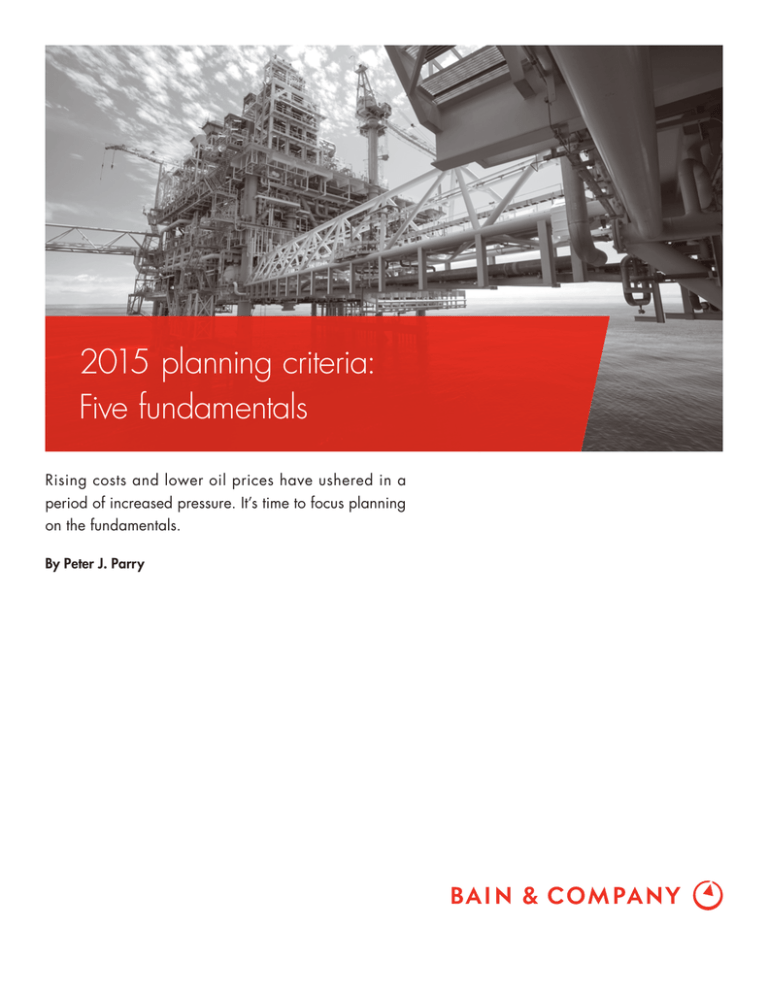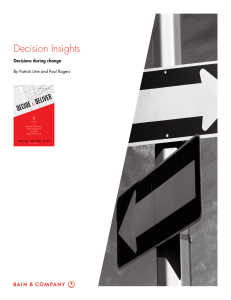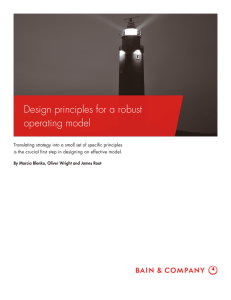
2015 planning criteria:
Five fundamentals
Rising costs and lower oil prices have ushered in a
period of increased pressure. It’s time to focus planning
on the fundamentals.
By Peter J. Parry
Peter J. Parry is a partner with Bain & Company in London. He leads the firm’s
Global Oil & Gas practice.
Copyright © 2014 Bain & Company, Inc. All rights reserved.
2015 planning criteria: Five fundamentals
Ben Hogan, one of the greatest golfers in the history of
the sport, believed that any golfer with average coordination could shoot below 80—if he applied himself patiently
and intelligently. Hogan’s 1957 thesis, Five Lessons: The
Modern Fundamentals of Golf, delivered on this promise
of simplicity by offering a short guide that helped even
the best professionals concentrate on the things that
really mattered in order to save strokes and deliver their
strongest performances on the fairway and the green.
•
Actionable oil price assumptions;
•
Realistic cost targets;
•
Operational predictability;
•
Capital project delivery; and
•
Investment in people and capabilities.
1. Actionable oil price assumptions. Oil and gas price
cycles have shortened—on the order of days and months
rather than years—and many executives are reacting
in real time or after the fact. They would be better served
by adopting through-cycle planning, which was popular
in the past. Setting price boundaries could help establish
scenarios that provide clear signals for action or intervention. For example, a Brent crude price band of $80
to $100 per barrel could be considered an affordable
range for some companies. Any dip below that price
could set in motion predefined steps to slow or delay
activities like longer-term, high capital-exposure projects.
Fluctuations above $100 could release funding for expansion projects. Realistic central bands in gas for planning
For the oil and gas industry, the biggest planning lesson
of recent years has also been one of simplicity: Focus
planning on the fundamentals to deliver strong results.
A short list of criteria can help executives frame the
thinking that goes into the strategic plan, drawn from
projections and budgets and from tracking to headline
performance. In recent years, while the oil and gas industry
has been targeting growth, Bain & Company has been
recommending a set of 10 planning criteria to help oil
and gas executives establish priorities (see the sidebar
on 2014 priorities). For 2015, because we believe getting
the right focus is more important than heroic ambition—
and inspired by Mr. Hogan’s example—we have simplified
the list to only five:
Figure 1: In recent years, major oil companies have witnessed significant cost inflation in their operations,
but many have optimistic projections for their ability to reduce costs
Operating costs for production
(indexed to 2008)
175%
Production costs
of major oil companies
(aggregated)
150
Norway’s offshore
production costs
(NPD forecast)
Majors’ cost-cutting ambitions
(illustrative)
125
Production costs
of Norway’s
offshore sector
100
75
2008
2009
2010
2011
2012
2013
2014
Notes: Major oil companies are BP, Chevron, ConocoPhillips, Eni, ExxonMobil, Royal Dutch Shell and Total.
Sources: Company reports; Norwegian Petroleum Directorate (NPD)
1
2015
2016
2017
2018
2015 planning criteria: Five fundamentals
could be in the range of $3 to $5 per million BTUs in
North America and $7 to $10 for the rest of the world.
The market is not likely to provide stability, so executives
must find ways to develop stable plans on their own.
With more than 70% of the world’s oil production
coming from fields that are older than 10 years (see
Figure 2), asset reliability and output predictability
are key. Almost all of these oil fields have reached or
passed their peak and will see declining production.
Many are well into their enhanced oil recovery (EOR)
and are more expensive to operate, more variable in
productivity and more prone to interventions and breakdowns. It’s important to provide realistic expectations
on the volumes that can be derived from these types
of assets rather than to predict theoretical maximums.
The P50 estimate comes with a wider variation in these
older fields.
2. Realistic cost targets. It’s certainly good news that
oil and gas companies are making serious efforts to
reduce upstream operating and capital costs; unfortunately, their cost improvement projections may be too
optimistic. Given that the past four years have seen
operating cost increases of around 15% annually for the
major oil companies (see Figure 1), it’s hard to imagine
reversing the trend and reducing costs by 10% or more
in 2015—although that’s what many are hoping for.
More realistic plans will estimate flat production costs
in 2015, with sustainable reductions arriving in 2016.
4. Capital project delivery. The stakes remain extremely
high for many project teams. Some very large projects
have not gone well in recent years, with cost overruns
more than double their budgets and missed start-up
deadlines—by months or even years. Yet when we look
at the next few years, a very large amount of capital (60%)
is targeted at mega projects, including more than $10
billion for large LNG projects (see Figure 3).
3. Operational predictability. In recent years, oil and
gas companies have found it difficult to deliver on
estimates for upstream production, especially those
predicting growth. Many factors affect performance,
and one of the most important is the maturity of the
field and its facilities.
Figure 2: Production volumes in older fields are erratic and difficult to predict; fields older than 10 years
dominate global liquids production
Average number of oil barrels produced per day
in a typical UK midsize oil field over the last 5 years
Global production
(millions of barrels per day)
50K
100
85
40
80
30
60
20
40
10
20
<10 years
>10 years
0
Jan
June Dec June Dec June Dec June Dec June Dec May
2008 2009 2009 2010 2010 2011 2011 2012 2012 2013 2013 2014
0
Total
Sources: Rystad Energy UCube database; UK Department of Energy & Climate Change's Petroleum Production Reporting System data, October 2014
2
2015 planning criteria: Five fundamentals
Figure 3: Of the next $1 trillion in the global oil and gas industry’s capital expenditures, 60% face a
high risk of escalating costs and schedule slippage
Cumulative
Capex
$1,000B
900
800
700
100 midsize
repeatable projects
of $1 billion to
$10 billion each;
moderate
cost escalation and
schedule slippage risk
600
500
25 mega projects,
half in LNG,
range from $10 billion
to $60 billion each;
high risk of
cost escalation
and schedule slippage
400
300
200
1000+ standard,
minor capital projects,
expansions,
replacement and
modification programs;
lower risk,
manageable delivery
100
0
0
5
10 15 20 25 30 35 40 45 50 55 60 65 70 75 80 85 90 95 100 105 110 115 120 125
Number of projects
Sources: IHS, Bain analysis
Given the challenging history of these large projects,
planners would do well to assign unique probabilities
to them. We suggest separating projects into several
categories, including routine upgrades and small projects,
repeatable projects and very large or new step-put technology projects. Categorizing would enable oil and gas
companies to begin establishing realistic Capex baselines and would provide greater visibility for their most
challenging large projects.
Executives would do well to remember the lessons
from the 1990s, when the last major round of personnel
cuts occurred. They should consider the longer-term
impact of cuts on capability—which is often not addressed
until after the capabilities have walked out the door. At
some point, the planning process should link people
costs with the productivity of assets. We would suggest
taking 20% of the cost savings and using it to invest in
skills, capabilities and strong centers of excellence.
Otherwise, we will again regret the loss of talent to other
industries, and oil and gas companies will feel the impact
on their midterm performance.
5. Investment in people and capabilities. The industry
has moved into another round of serious reductions in
head count, including some widely reported cost-cutting
programs at several oil majors. Some national oil companies (NOCs) are looking to quickly trim corporate
centers and staff functions, and independents are making
changes to their business models—consider Hess’s
focus on unconventionals, Occidental’s California spinoff and Chesapeake’s portfolio rationalization. Given
that personnel costs and local requirements represent
about one-quarter of budgets, there’s always a tendency
to look there first when reducing costs.
Getting a strong grip on these five fundamental planning
criteria will help executives steer their companies along
a positive course in 2015 and beyond. Once performance
delivery is under stronger control, the planning agenda
can again become more diverse and strategic in nature.
But even as companies aim to deliver a return on capital
of more than 12%, and strive for 20%, keeping things
clear and simple, as Ben Hogan advised long ago, is the
best course for 2015.
3
2015 planning criteria: Five fundamentals
What happened to the 2014 planning criteria?
The oil and gas industry’s priorities and performance in 2014 suggest the planning agenda has been
taken apart piece by piece, with only a few players (Canadian Natural Resources, Woodside and
Anadarko) staying ahead of the curve. Most are now racing to catch up with the realities of thinner
upstream margins, limited availability of capital and pressure to reduce costs and head count.
The indicators we saw in September 2014 have played out in interesting ways, with some organizations
better prepared than others to respond.
1. Low real interest rates. What will a period of sustained low-cost capital enable us to do?
Low-cost capital seems to have bypassed the oil and gas industry, due largely to conservative debt
positions for the majors and higher-cost leverage for independents. Many NOCs now also struggle
with longer-term funding. The US Energy Information Administration reported that for the year ending
March 31, 2014, the 126 oil and gas companies it had reviewed had added $106 billion to debt
and divested $73 billion in assets.
2. The new normal of political risk. How can we plan better for short-term disruptive political risk?
Overall, the industry remains in a reactive mode, relying on its historical capability of riding out
disruptions. The past year’s events in Iraq, Russia and Scotland have longer-term consequences and
should have led to a decrease or halt of investments.
3. Capabilities and capacities. How can we strengthen our talent pool and organize more effectively?
Most oil and gas companies have headed in reverse, reducing head count with a vengeance. They may
see short-term productivity gains, but building capabilities is essential to long-term success.
4. Inflation. How should we account for sector inflation?
It’s difficult to imagine moving from double-digit inflation to double-digit cost reduction in one jump.
Lower rig rates will help, but managing the cost of ownership has to become a core capability.
5. Oil and gas price volatility. How can we plan effectively, given the volatility in prices?
The weaker oil prices of the past few months have taken many by surprise. We will see $80 per
barrel as the new threshold for a positive business case on new projects, $4 per million BTU for
North American gas and $8 for gas in the rest of the world.
6. Longer-term project pipeline quality. What plans should we make to extend growth beyond the
completion of major projects after 2017?
The short-term focus of 2014 has made this difficult. Major LNG commitments are being made, but
meanwhile the focus on midsize oil developments could be improved.
7. Exploration focus. Where will we focus, and how will we ensure adequate reserves?
We have entered a world of high and low performers in exploration. On the high side, Statoil, Eni,
Noble and many of the US shale independents show strong contingent resource and reserve growth.
Others, including the majors, are finding it hard to replace 60% of production from exploration
additions. For explorers, 2015 will be a vital year given that the discretionary cost cuts put exploration
budgets at risk.
8. Gas. What role will gas play?
Producers continue to place big bets on gas in unconventionals, LNG and exploration programs.
Limited effectiveness and progress around carbon pricing keeps gas undervalued relative to oil, but
holding half the portfolio in gas assets has been a good planning rule to follow.
The last two areas—major projects start-up and realistic operational delivery—remain challenging
and feature in this year’s fundamentals.
4
Shared Ambit ion, True Results
Bain & Company is the management consulting firm that the world’s business leaders come
to when they want results.
Bain advises clients on strategy, operations, technology, organization, private equity and mergers and acquisitions.
We develop practical, customized insights that clients act on and transfer skills that make change stick. Founded
in 1973, Bain has 51 offices in 33 countries, and our deep expertise and client roster cross every industry and
economic sector. Our clients have outperformed the stock market 4 to 1.
What sets us apart
We believe a consulting firm should be more than an adviser. So we put ourselves in our clients’ shoes, selling
outcomes, not projects. We align our incentives with our clients’ by linking our fees to their results and collaborate
to unlock the full potential of their business. Our Results Delivery® process builds our clients’ capabilities, and
our True North values mean we do the right thing for our clients, people and communities—always.
Key contacts in Bain’s Global Oil & Gas practice
Europe,
Middle East
and Africa:
Lars Jacob Boe in Oslo (larsjacob.boe@bain.com)
Luca Caruso in Moscow (luca.caruso@bain.com)
Juan Carlos Gay in London (juancarlos.gay@bain.com)
Lili Chahbazi in London (lili.chahbazi@bain.com)
Christophe de Mahieu in Dubai (christophe.demahieu@bain.com)
Raed Kombargi in London (raed.kombargi@bain.com)
Marc Lamure in Paris (marc.lamure@bain.com)
Torsten Lichtenau in London (torsten.lichtenau@bain.com)
Olya Linde in Moscow (olya.linde@bain.com)
Roberto Nava in Milan (roberto.nava@bain.com)
Peter Parry in London (peter.parry@bain.com)
Tiziano Rivolta in Milan (tiziano.rivolta@bain.com)
Karim Shariff in Dubai (karim.shariff@bain.com)
Natan Shklyar in Moscow (natan.shklyar@bain.com)
John Smith in London (john.smith@bain.com)
Matt Taylor in London (matt.taylor@bain.com)
Luis Uriza in London (luis.uriza@bain.com)
Americas:
Riccardo Bertocco in Dallas (riccardo.bertocco@bain.com)
Pedro Caruso in Houston (pedro.caruso@bain.com)
Ricardo Gold in São Paulo (ricardo.gold@bain.com)
Eduardo Hutt in Mexico City (eduardo.hutt@bain.com)
Jorge Leis in Houston (jorge.leis@bain.com)
Rodrigo Mas in São Paulo (rodrigo.mas@bain.com)
John McCreery in Houston (john.mccreery@bain.com)
John Norton in Houston (john.norton@bain.com)
Ethan Phillips in Houston (ethan.phillips@bain.com)
José de Sá in São Paulo (jose.sa@bain.com)
Asia-Pacific:
Sharad Apte in Bangkok (sharad.apte@bain.com)
Francesco Cigala in Kuala Lumpur (francesco.cigala@bain.com)
Lodewijk de Graauw in Perth (lodewijk.degraauw@bain.com)
Dale Hardcastle in Singapore (dale.hardcastle@bain.com)
Brian Murphy in Perth (brian.murphy@bain.com)
For more information, visit www.bain.com









